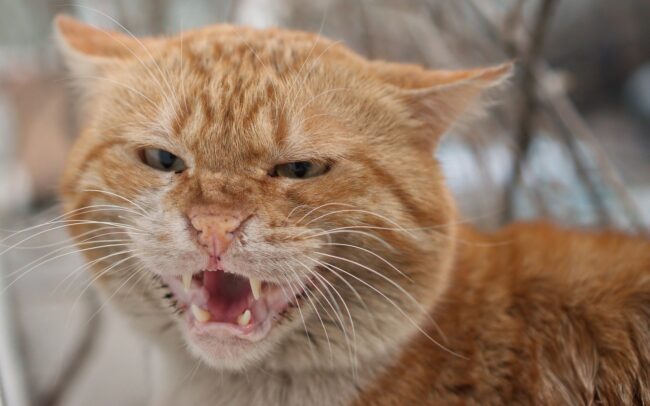Table of Contents
Misalignment of teeth in cats is a common problem affecting their well-being. Malocclusion can occur from a variety of conditions including an injury and is often seen to worsen with time as the teeth structure of the cat grows.
In this guide, let us try to learn more about cat malocclusion and understand different types of teeth misalignment including underbite, overbite and snaggletooth. We also discuss what pet owners can do about such conditions.
Cat Malocclusion – A Complete Guide
Kittens generally have 26 teeth erupting in the early months of their lives. Adult cats can have up to 30 permanent teeth classified into molars, premolars, incisors and canine teeth. Occlusion refers to the way teeth align with each other in pets. A normal occlusion is when the upper incisors overlap the lower incisors and the lower canines have equal distance between the upper canine and the upper third incisor. It also has the premolar crown tips of the lower jaw pointing between the spaces in the upper jaw.
Malocclusion is when the cat has an abnormal tooth alignment. They are two types – dental and skeletal. Skeletal malocclusion is when the length of the lower jaw is abnormal in relation to the upper jaw. Such a misalignment causes the teeth to look out of orientation with each other. On the other hand, a dental malocclusion occurs when the lengths of the lower and upper jaws are normal but one or more teeth have been out of alignment.
Whenever the malocclusion results in trauma to the tissues in the mouth or other teeth, it is known to be traumatic and requires treatment. Some of the most common treatment options include moving the affected teeth, extraction and creating a space for the misaligned tooth through surgery.
Cat Overbite
Also called by the names overjet, overshot and Class 2 malocclusion, overbite is a teeth misalignment where the upper jaw is longer than the lower jaw. This results in a gap between the lower and the upper incisors upon closing the mouth. Cats born with this problem often get it corrected if the gap is not too big.
However, if it does not resolve before the cat’s bite sets at ten months, the condition will not improve on its own. The cat overbite may worsen as the pet gets its permanent teeth because they are bigger and can easily damage the softer tissues in the mouth. This sometimes calls for treatment including extraction.
Cat With Underbite
A teeth misalignment is more severe and problematic in cats than in other animals. Breeds like Himalayan cats and Persians have a higher tendency of developing malocclusion like an underbite. This condition is also called undershot or class 3 malocclusion and occurs when the lower jaw is longer compared to the upper jaw with the lower teeth protruding in front of the upper teeth.
A cat with an underbite can have a low discrepancy with the upper and lower incisors meeting edge to edge with each other. This type of occlusion is also called the level or even bite. A cat with an underbite should be evaluated by a vet to find out if it has a traumatic bite which can be painful. These abnormal bites can often be painful and the sooner you treat them, the better are the chances for your cat to get a pain-free, functional bite.
Cat Snaggletooth
A snaggletooth is one of the most commonly reported complaints among pet owners. It is when the cat has a misaligned tooth from others. In this case, the individual tooth may be misaligned or growing in the wrong direction when compared to the misalignment condition of the whole mouth. While there are several causes of teeth misalignment in cats, most problems occur when either the individual teeth or jaw fail to grow at the normal rate.
Some of the most common causes of teeth misalignment include too many teeth, trauma to the face, poor nutrition, hereditary or congenital defect or failure to lose baby teeth. In presence of such a misalignment, the cat is likely to face difficulty picking up food and chewing while being inclined to eating up only bigger pieces of food. Such cats are more prone to developing plaque and tartar.
Cat Jaw Out Of Alignment? Here’s What To Do
If you find that your feline has either jaw out of alignment, it is important to address it at the earliest because it can cause an abnormal bite affecting function and resulting in pain. While it is not possible to correct teeth or jaw misalignment, there is always something pet owners can do to improve the bite and enhance comfort. The key is to diagnose malocclusion as early as possible.
Diagnosis of this condition in cats starts with a thorough physical examination of the cat, its mouth and jaw. The vet should count the number of teeth and try to find out whether the cat gets any teeth near the retained baby teeth. Cats as young as six months can be diagnosed for misalignment. Apart from physical examination, the vet can ask for x-rays to confirm any presence of baby teeth. Such tests allow ruling out structural defects to identify the cause of the problem.
In most cases, misalignment is left untreated to correct itself as the mouth develops room for the teeth. The exact treatment depends on the age and severity of the condition. The vet can look at the test reports to find out if they are likely to self-correct. In some cases, tooth extraction may be necessary to make room for other teeth.

